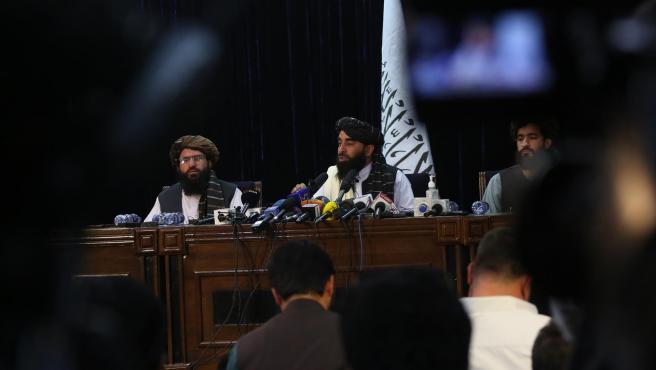The Taliban surprised the world by regaining control of Afghanistan in just over ten days , a country that is larger than Spain in size. After several days of an unstoppable advance, and while the international media clamored for the dark future that awaits the Afghans, dozens of images of the Taliban entering Kabul ran through social networks . However, the expected typical frames of any war conflict were replaced by scenes of armed combatants riding in bumper cars, eating ice cream or exercising in gyms .
In turn, at a press conference with a detailed image, speaking in English and before the cameras of several countries, Zabihullah Mujahid, the Taliban spokesman, astonished public opinion with a message of harmony. The fundamentalist group that two decades ago prohibited its citizens from using all kinds of technology, now flaunts them to get its message to the world, in an unexpected propaganda strategy .
Almost a million Americans wonder what they fought for in Afghanistan
The so-called Taliban 2.0 seem to be adopting a communicative pragmatism that they did not have during the years 1996 and 2001, when they ruled Afghanistan under an iron regime and where the images of their own leaders were unknown, with few public appearances. Today, aware of the power that the internet can bring them, the Taliban are heading abroad for the first time , in a 180 degree turn in their communication strategy.
Pablo Sapag, professor of the History of Propaganda at the Complutense University of Madrid and a war correspondent who covered Afghanistan in 2001, assures 20 minutes that the Taliban are “in a moment of transition in which what they seek is not to attract excessive attention. in negative terms and that has led them to carry out a crisis communication strategy trying to present a more positive image of themselves “.
“The Taliban have realized that in this phase, while the eyes and attention are on Afghanistan, they have to send that message of restraint, both from the point of view of form and substance, ” he adds.
How has the Taliban propaganda changed?
For experts, the most significant thing about this situation is the intention of these messages and the audience to which they are directed. The first difference that we can establish is that initially its addressee in the nineties was the population that lived in that region, while now they are also trying to convince the western public .
As recognized by the researcher from the UCM Cultural Semiotics Study Group, Miguel Martín, “when one of the first statements abroad is that they are going to respect the rights of women within how they interpret the Islamic norm Obviously the recipient is on the one hand the Afghan population, specifically women, and on the other hand Western society and governments “.
They are trying to send a message of confidence to the western governments so that they do not interfere in the short term in the Afghan policy and also, evidently, not to generate fear or bad press between the western society, adds Martín.
This interest in using social networks and the internet to change their disastrous image has been a constant since the beginning of the Taliban offensive. The messages and videos of support that have circulated on social networks in recent weeks may seem spontaneous, but they are more organized than you would expect in a group that has historically reneged on technology .
According to an investigation by the British newspaper The Times , more than 100 new accounts and pages on Twitter and Facebook related to the Taliban have appeared since August 9 . In addition, profiles on social networks of personality of the Islamist group that had been inactive for months or years, reactivated their activity in recent weeks.
Despite the fact that for a long time the Taliban communicated with the outside world through countries with which they had a relationship, such as Pakistan, or by sending messages to media such as Aljazeera , years ago they began to use platforms such as Twitter, Facebook or YouTube to spread your message.
- Sami Yousafzai (@Samiyousafzai) August 17, 2021
The digital medium Vice collected a few days ago the statements of a Taliban spokesman to AFP in 2019: ” We are not against modern technology … This is the need of the moment and its use is not against the Islamic Sharia.”
Another important factor is the penetration of the Internet in Afghanistan, which shows how the campaign through these channels has little to do with the average Afghan. In Afghanistan, Internet use is around 15% of the population and especially in its capital , Kabul .
“The capital should not be confused with the rest of Afghanistan. Kabul continues to be a mirage and especially that of the last 20 years, which has lived the dollars of international troops, aid agencies, of some companies … but the Real Afghanistan; the interior; the rural, it has absolutely nothing to do with it, “explains Sapag. “In the interior of the country they do not need the internet to spread the word. There is a non-negligible percentage of the population that supports the Taliban (…). To the rest of the population that does not agree with them, the propaganda is aimed at terror or fear” .
“Surely when Afghanistan disappears from the (media) agenda, the strategy will return to what they had: very little foreign propaganda, at most to the States with which it may have a closer relationship and armed propaganda inside. of terror “, acknowledges the professor, who adds that terrorism” is essentially a propaganda action, which can be summed up as “it kills one and scares 100,000”.
Islamic State speaks of Taliban “false victory” and attributes its entry into Kabul to the US
On the other hand, the use that the Taliban make of these forms of communication has little or nothing to do with other groups that are framed within the so-called jihadists, such as the Islamic State or Al Qaeda.
A radical difference between the two organizations is that unlike the Taliban, the Islamic State “puts the accent on creating a very powerful communicative structure, a Hollywood-style audiovisual industry that supports its message,” recalls Miguel Martín.
Likewise, the messages of both groups are clearly different, since the Taliban try to moderate their discourse and adapt to what they believe is well seen abroad , sending messages of supposed respect for women and human rights, while States Islamic seeks to provoke terror and fear.
In addition, ” the claim of the Taliban is not so much to configure a caliphate at a global level as what the Islamic State intends, breaking existing borders, but is to create a State that follows Islamic law, according to its interpretation, within its territory. “adds Martín.
On this issue Sapag adds that the Taliban movement ” does not intend to act outside the territory of Afghanistan , which marks a clear communicative difference with respect to Al Qaeda and the Islamic State. The latter two are jihadist organizations of the global type that necessarily need to address a much wider audience. “
Is it a strategy with a chance of being successful?
If there is a question that has arisen these days about the Taliban, it is whether or not the message they convey is real. The fact that, after having established a government that violated human rights and that during the last 20 years they have carried out a multitude of attacks, there is a doubt as to whether or not the Taliban have modified their ideals is in itself a victory of the Islamist group .
However, this does not mean that the whitening campaign on the networks automatically causes a change of opinion with respect to this group. “Platforms such as Facebook, Twitter, WhatsApp, Instagram or others, if used well have a propaganda effect, but I think the Taliban have lost the battle of propaganda in the internet universe and in particular in social networks (…). At best, they may be interested in making selective propaganda through networks, towards some countries with which they do aspire to have better relations that will allow them to stabilize the new regime, “acknowledges Sapag.
A Taliban surrounded by children in the demonstrations.
Journalists Targeted by Taliban: “Already Conducting Organized Operations to Find Them”
For the professor of the History of Propaganda, these messages of moderation “mainly benefit the retreating troops, the United States, the United Kingdom and the NATO countries, to cover up their failure and to give the idea that in reality they do not what has happened is so serious . “
Meanwhile, Amnesty Intentional warned last Friday of “a massacre” perpetrated by Taliban fighters against men from the Hazara ethnic minority in the Afghan province of Ghazni, in the center of the country. In addition to the alleged persecution of which several Afghan journalists are warning.
In the digital age, even wars seem to be fought on social networks , and the battle of the story that the Taliban wage on the internet is one more example of this.









